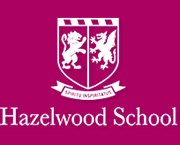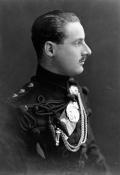
War Memorial
| Major Alwyn Lionel Compton CAVENDISH Croix de Guerre | |
|
B Company, 8th (Service) Battalion Rifle Brigade (The Prince Consort's Own) Date of birth: 26th March 1890 Date of death: 28th August 1928 Died aged 38 Buried at sea |

|
| Alwyn Lionel Compton Cavendish was born at Mysore in India on the 26th of March 1890 the only child of Ernest Lionel Francis Cavendish, HM Prison Service, and Jessie (nee Jenkins) Cavendish later of "Arniesyde", St Boswells in Roxburghshire. He was christened at Vellore, Madras on the 1st of May 1890. He was educated at Brunswick Court Young Gentlemen's School in Haywards Heath and at Hazelwood School until July 1904 where he was a member of the Choir. He was a member of the Cricket XI in 1903 and 1904 when he was Captain. He was a member of the Football XI in 1903. The school magazine wrote of his 1903 cricket season: - "A very deserving cricketer and looks like being useful next year both with bat and ball." They wrote of his 1904 cricket season: - "Captain, full of energy, and only wants to watch the position of his field a little more to be a really good captain, his own brilliant fielding setting an excellent example. Has a good forward stroke and plays well off his legs; and when he learns to play back without bending double will make a fine bat. A fairly good bowler." The magazine wrote the following on his 1903 football season: - "(Outside Right) - Immensely improved; is not a clever dribbler, but goes very straight, and both shoots and middles with no little vim and accuracy." On leaving the school the magazine wrote the following of him: - " ....goes to Cheltenham. He has been one of the best and keenest, both at cricket and football, and a capital chorister and musician." He went on to Cheltenham College where he was in Christowe House and was a member of the Choir. He left in 1908. He played cricket for the Warwickshire Gentlemen in 1908; later that year he entered the Royal Military College Sandhurst which he left in August 1909. He was commissioned as a 2nd Lieutenant in the 3rd Battalion Rifle Brigade (The Prince Consort's Own) on the 4th of December 1909 and was promoted to Lieutenant on the 23rd of September 1911. Following the outbreak of war in 1914 he was transferred to the newly formed 8th Battalion of his regiment and was promoted to Captain on the 2nd of December 1914. He embarked for France with his battalion in May 1915. On the 5th of July 1915 the 8th Battalion Rifle Brigade was holding trenches at Railway Wood, to the south east of Ypres. At 9am that morning the Germans began a heavy artillery barrage of the British trenches which lasted two hours. When the barrage stopped an attack was made on the Rifle Brigade's front line by twenty German bombers. Alwyn Cavendish organised and led a counter attack which drove them back to their own lines. On the night of the 29th of July 1915 the battalion relieved the 7th Battalion Rifle Brigade in trenches at Hooge in the Ypres salient. Alwyn Cavendish's B Company was deployed in dug outs near the north west corner of Zouave Wood with one platoon in support one hundred yards due south of the wood. The trenches were deep and narrow but with little or no wire in front of them. At 3.15am on the 30th of July the Germans attacked, unleashing an intense bombardment on the Rifle Brigade front line. This lasted only two or three minutes before a "sheet of flame" broke out along the front as the Germans turned on "liquid fire" from hoses they had run out into no man's land during the night. Enemy bombers appeared in large numbers along the flank of the fire. Before long the machine guns were out of action and the enemy infantry and bombers broke into the Rifle Brigade front line, swinging left and right despite the desperate defence mounted by the defenders. Between 4am and 5am B Company mounted a counterattack but this was beaten back by machine gun fire although they were able to give effective covering fire for the remnants of A Company as they fell back. Throughout this time Zouave Wood was under heavy artillery fire but some relief came in the form of a Company of the King's Royal Rifle Corps who reinforced the position at 9am. Later in the morning orders came through for a counterattack to take place at 2.45pm which was to be preceded by a forty five minute supporting artillery bombardment. At 2.45pm the counterattack began but the artillery had left the enemy machine guns untouched and the attack quickly failed with heavy casualties. The battalion was relived at 2am the following morning having suffered casualties of six officers killed with three officers missing and ten wounded as well as eighty other ranks killed with two hundred and sixty seven wounded and one hundred and thirty two missing. A further five other ranks were suffering from shell shock. Alwyn Cavendish was among the wounded. He was promoted to Major and returned to the front in March 1916 where he served as second in command of the 8th Battalion until being forced to return home with an attack of dysentery. He was mentioned in despatches on the 1st of January 1916. Towards the end of 1916 he again returned to France and served as an Intelligence Officer for the 14th Division Headquarters before being attached to the 1st Battalion of the Rifle Brigade in early 1917 where he served in A Company. On the 9th of April 1917, the first day of the battle of Arras, the battalion attacked the German position known as the Hyderabad Redoubt. They were in support of the attack and didn't move forward until 3.40pm. They initial advanced some one thousand yards when a deluge of German artillery fire fell on the Rifle Brigade men. Although they took their objective, casualties were heavy with A Company losing all their officers including Alwyn Cavendish who was severely wounded. On his recovery he served at the War Office from the 20th of August 1917 until he retired from the army on the 24th of January 1920 with the rank of Major. He was awarded the Croix de Guerre and was mentioned in despatches. He was married on the 18th of August 1917 to Muriel Cecil Harriett (nee Heaton-Ellis), widow of Lieutenant Richard Greaves-Sawle, 2nd Battalion Coldstream Guards who had been killed in action on the 2nd of November 1914; they had a son, Charles Francis Alwyn Compton, born on the 29th of May 1919. They lived at 4 Cliveden Place, Eaton Square London SW1 and he was a member of White�s Club. In 1926 he became Assistant Commissioner of the Sudan Police and in 1927 he was appointed as Deputy Commissioner in the Mongolla Province. He died at sea of blood poisoning on his way back from the Sudan and was buried at sea. He is commemorated on a marble tablet at St Giles' Church, at Wyddial in Hertfordshire. (Photograph by kind permission of the Imperial War Museum HU119720) |
|
| Went on to Cheltenham College |
Back